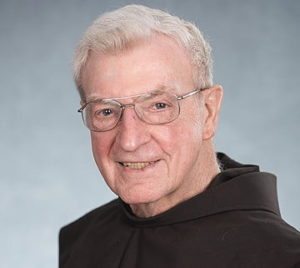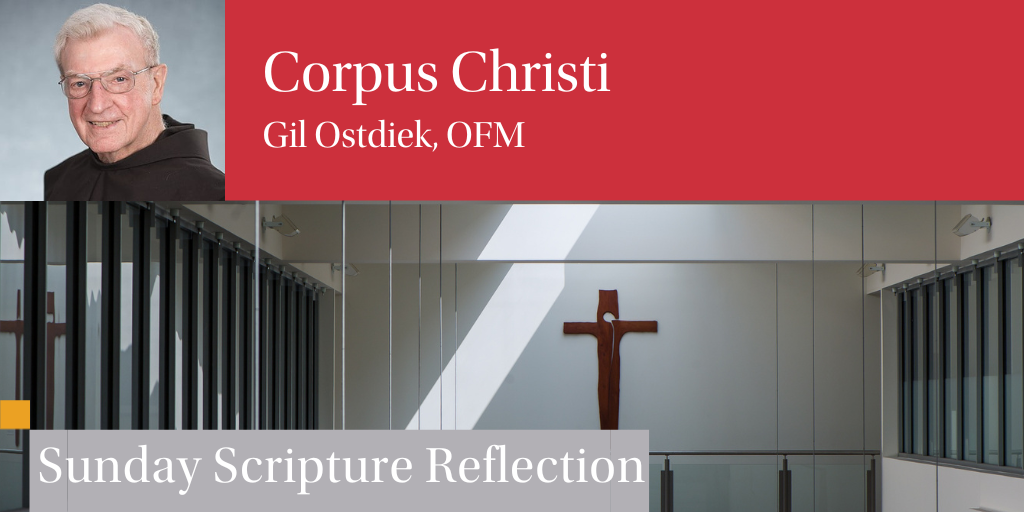
Readings:
Reading I: Gen 14:18-20
Psalm 110:1, 2, 3, 4
Reading II: 1 Cor 11:23-26
Gospel: Luke 9:11b-17
“Do this in memory of me.”
This reflection follows a somewhat different pattern. We will first retrieve memories we may have of the feast, then explore how it started and what it has meant, and finally visit the readings to discover what it can mean for us today.
Memories to ponder
What do you remember? Celebration of a Mass, much like ordinary Sundays? Perhaps after Mass a procession with the Blessed Sacrament around parish grounds or through the blocked-off streets of the neighborhood? With stops at temporary outdoor altars for a blessing with the monstrance? With final Benediction back in church? Picture to yourself the procession of people, the sights, sounds, feelings this procession evoked. Did you ever wonder why we did this? The answer goes back to its beginnings.
Origins and meaning
It began in Liège [Belgium] almost eight centuries ago, in 1246. At that time there were vigorous theological debates in medieval universities about Christ’s presence under the appearances of bread and wine. When and how did this presence happen? Over the course of a century or more theologians gradually settled on a true presence underneath those appearances, effected by a change of substance from bread to the glorified body of the risen Savior, through the words of consecration. This explanation used an abstract Aristotelian theory of causality, which few ordinary people understood.
In the meantime, the people had also been reduced to passive attendance at a Latin Mass they could not understand. Their participation consisted of gazing on the host elevated for adoration. Holy Communion was extremely rare. Adoration became their primary source of spiritual nourishment, first during Mass and then in eucharistic devotions outside of it. That devotional response to the Eucharist was particularly strong in northwestern Europe.
Juliana of Liège grew up in that milieu. She came to understand, through visions and prayer, that Jesus deserved a more solemn and joyful feast than the celebration of Holy Thursday. That feast focused on the foot washing, and the Eucharist seemed to her to be overshadowed by Good Friday celebration of the passion. She revealed her yearning for a special feast honoring the Body of Christ to Robert of Turotte. He soon became Bishop of Liège and established the feast of Corpus Christi for his diocese in 1246. Juliana hoped for a celebration of joyful thanksgiving and adoration, with actual Holy Communion. The Bishop added the goal of confronting unorthodox eucharistic beliefs. The feast gradually spread eastward and finally to Rome where Bishop Robert, now Pope Unban IV, made it a universal feast for the Western Church in 1264.
Procession with the Blessed Sacrament, not part of the original feast, was added later. It grew in popularity until it became common in the 14th century. It gradually became more elaborate, involving not only the clergy and those at Mass, but also civil and political dignitaries and members of confraternities and guilds. As a result, the procession began to overshadow the Mass and became a full celebration of popular religiosity.
The focus on the procession has continued today in places such as Toledo in Spain. The procession wends its way through the narrow streets of the old city. Continuous awnings cover those streets from house to house, banners and ancient tapestries hang from windows and balconies, fragrant flowers and aromatic herbs are strewn along the streets; their scent lingers for days. An exquisite monstrance [over 10 feet tall] made by Enrique de Arfe of gold and silver, shaped like the facade of a gothic cathedral and adorned with precious gems and 260 figurines, is caried through the thronged streets
Readings: meanings for today?
Our context is quite different. Full participation in the Mass has been restored, with reception of Holy Communion by all [Trent affirmed that adoration is appropriate, but Christ is present primarily to be received]. Today elaborate processions have declined. Active participation in the Eucharist itself is now our best source of spirituality.
What can the feast mean? Ponder the words used in the readings and sequence ─ bread and wine, eat and drink, food and feast, supper and guests and sharing; flesh and blood [oneself], broken and poured, proclaiming the Lord’s death, a sacrifice of praise; dismiss the crowd, give them some food yourselves, five loaves and two fishes are all we have, twelve wicker baskets filled with leftover fragments ─ savor these words.
True to Juliana’s inspiration, Eucharist is about food from heaven given to humans, nourishing, shared, by table companions [com + pane], becoming bread [like Christ] to nourish those excluded from the table, starved for dignity and justice, victims deprived of all that nourishes human dignity and worth.
What, then, does the feast ask us to do? To do what Jesus did, in memory of him. Not just performing a table ritual, a set of rubrics or stage directions. He identified himself [body and blood] and committed himself to be broken and poured out on the cross as food and drink for those hungry and thirsty. A total gift of self, offered to all, unbreakable pledge of God’s lavish and unconditional love. His way of total self-gift in love for others is the “this” that Jesus did in his life, at the Supper, and on the cross. Giving of ourselves is the “this” he sends us out to “do in memory” of him.
Could not our “doing this” be our contemporary version of the Corpus Christi procession? In baptism we have all become the Body of Christ. Every celebration of the Eucharist reaffirms that baptismal calling to be Christ to the world. To bring Christ to the world would not have to wait for Corpus Christi each year. At every Mass we are all sent to take up our daily journey of a eucharistic way of life, without the fanfare of a procession. A life with and in Christ, to be Christ to others, and by silent witness to show them his face, the face of God’s love and mercy. Sent to do just “this” in memory of Christ.
